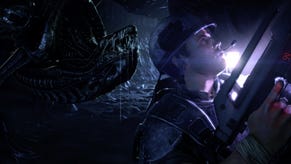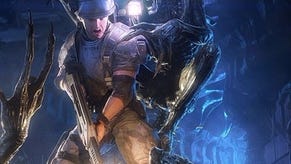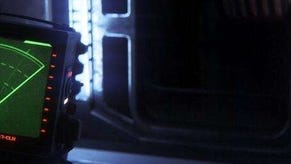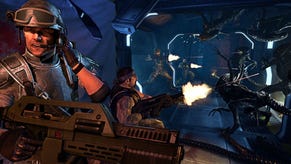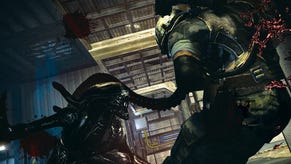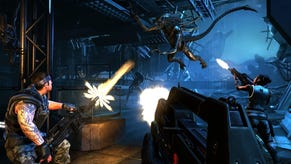Face-Off: Aliens: Colonial Marines
Hudson, run a bypass.
| - | Xbox 360 | PlayStation 3 |
|---|---|---|
| Disc Size | 6.2GB | 6.6GB |
| Install | 6.2GB (optional) | 2.7GB (mandatory) |
| Surround Support | Dolby Digital | Dolby Digital, DTS, 5.1LPCM |
Given the potential for fitting the Aliens universe into a suspenseful first-person adventure, the firm but fair Eurogamer score for Aliens: Colonial Marines comes as dismaying news, but perhaps we should have seen the fire on the horizon. The signs of development hell are writ large when a game's first unveiling dates back over half a decade and where the studio credits are divided across four separate offices. In this case, we see Gearbox Software at the heart of the game's lengthy span of development, while segments of the solo campaign and multi-player are outsourced to TimeGate Studios and Nerve Software, respectively. The journey towards nailing a final release date has been described by one former Gearbox employee as "a total train wreck" though the jury is still out on the condition of the Wii U version, currently being handled by Demiurge Studios.
So what have we got? The game is built around Unreal Engine 3, with a modified renderer plugged in to allow for a more advanced dynamic lighting system. An early tech demo from E3 2011 showed this idea had real relevance to the tone of the films, especially when navigating around dark wastelands armed with just a flashlight to show the way. In a well-considered fusion of art and tech, designs of planet LV-426 were handed over by the film's original concept artist, Syd Mead, and backed up in this fashion by stencil buffers to cast stark shadows wherever you looked - a method that may call to mind other claustrophobic corridor-based shooters, such as Doom 3 or FEAR.
From a level design standpoint, the source material is clearly well-studied, and the look of the umbilical bridges leading from the Sulaco spaceship, plus the spindly xenomorph egg chambers, impress on first sight. However, technical issues with the game bubble to the surface quickly once these areas are filled by skittish marine allies and weightless alien AI - all of which suffer from collision glitches around the environment.
So, to see which format makes the best of a bad situation, let's get onto the Face-Off proper. With no sign of even the Wii U version's launch date as of yet, we took one for the team by playing through the 360, PS3 and PC versions in the meantime. As usual, we have our head-to-head videos below to showcase image quality, backed up by a large triple-format comparison gallery.
"A disastrous result on console, the PC version at least offers some significant graphical upgrades that enhance the core atmosphere of the game."
Alternative comparisons:
- Aliens: Colonial Marines - PlayStation 3 vs. PC
- Aliens: Colonial Marines - Xbox 360 vs. PlayStation 3
While the game can have its moments visually, these instances are few and far between. In terms of the overall presentation, the 360 version is without a doubt the worst offender of the three, running at a sub-HD native resolution of 1152x640 with no apparent attempts at conventional anti-aliasing. The engine incorporates post-processing effects such as bloom to hide sharp edges where possible, but this doesn't always blend well with the new lighting system. Instead, the game's environments contrast deeply gloomy environments with long lines of vivid white light, which only exacerbates the problem. Even the fast approximate anti-aliasing (FXAA), offered via a toggle in the PC version, could have saved the day here at a fairly minimal expense to performance.
The PS3 version is also bereft of any supporting AA, but at least runs at a full native 1280x720, avoiding any upscaling artifacts. Sony's platform also commands an advantage for its use of subtler anistropic texture filtering, which avoids the obvious level-of-detail cascades seen on 360. For Microsoft's console, these manifest as three separate lines in front of the player which run equidistantly, blurring the floors and walls as they pass across. Given the 360's advantage in other games founded on Unreal Engine 3 tech, this is a surprising role reversal.
The third major problem with the 360 version is its abundant tearing, which we cover in the performance videos below. Once again, the mixture of stark light and dark tones in Colonial Marines' spaceships and alien hives means that when a frame splits in half, it is seen very easily. This appears as an aggressive flicker across the entire screen for most, and is a near-constant fixture from the start until the end of the game. It goes to surprising extremes too, and even affects the 360's pre-rendered CG cut-scenes and introductory logos - which would usually be v-synced - while on the other hand, the PS3 doesn't suffer from any such issues, and gameplay runs with noticeably fewer torn frames.
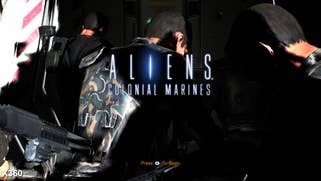

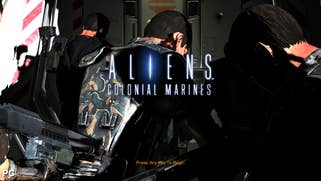


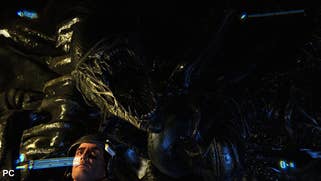
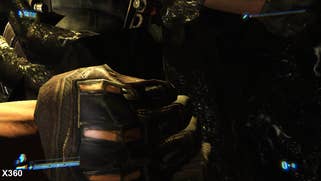
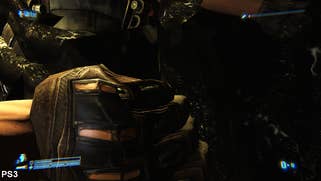


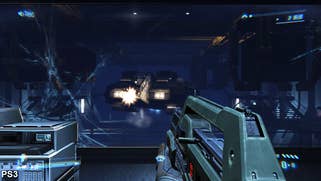

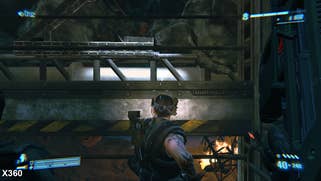
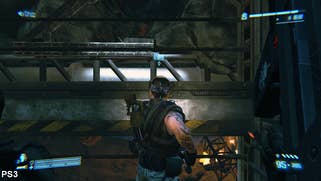
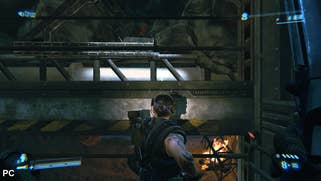


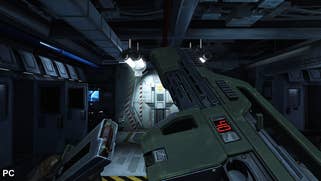

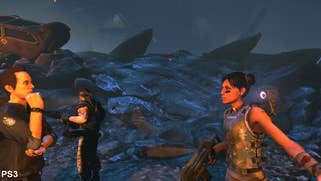
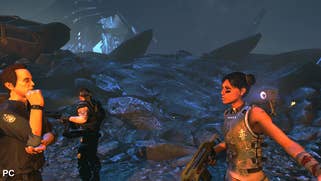
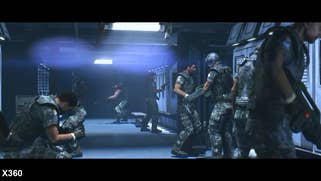
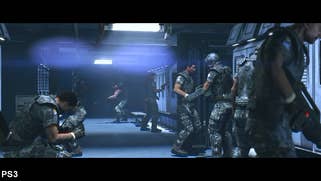

Texture pop-in is an issue for both console platforms too, even with the 360 version's optional HDD install, as per our tests. The PS3 version forces a 2.7GB install before play starts, and despite the extra downtime, scenery still takes longer on this machine to stream across to higher-resolution assets. This typically leaves objects looking like clay models for several seconds, often at the start of a level or cut-scene. There's no marked difference in asset quality once they do load, however, with both platforms turning in similar results - the one exception being the gloves on the lead character, which are permanently running at a higher level of detail on PS3.
The dynamic lighting system for Colonial Marines ranks as a great bullet-point feature at first, but it's ultimately underused here. The full possibilities of the system only work as intended on PC when set to medium shadow quality or above, with every object in the environment reacting to your character's position. By comparison, the PS3 and 360 versions operate at the lowest setting, meaning lights from your flashlight do not affect other AI characters or geometry - though those mounted to the ceiling will. The results appears disjointed and inconsistent, and for the sake of atmosphere this is a real missed opportunity. Many other shadows are pre-baked into the environment to save on processing power, and of the two console formats, the number of light sources on screen concurrently appears to have been scaled back on PS3 - noticed immediately on the gloomier opening bridge section.
For each release, the implementation of the dynamic lighting is odd, with the angle of your torch causing some vexing shadow angles. In theory, the light source starts from the character's shoulder on PC, but in situations where we stand too close to an object we somehow find the shadow of our entire body snapping into view. Similarly, our position in relation to dynamic lights overhead can often send the character's shadow in entirely the wrong direction, which can be equally jarring.
The PC version also offers settings for much improved textures, sharper dynamic shadows, plus sliders for field of view and world detail. For flooring and rock formations, textures remain as low resolution as their PS3 and 360 incarnations, though the real boost in detail is evident on the bump-mapping to the xenomorphs themselves. The secondary benefit of running the texture slider on full is the use of improved texture filtering, which removes the excessive blur we see two strides ahead on 360 version - a must for those running at resolutions as high as 1080p. Meanwhile, the highest world detail setting adds new atmospheric effects to the environment, such as lens flare and smoke.
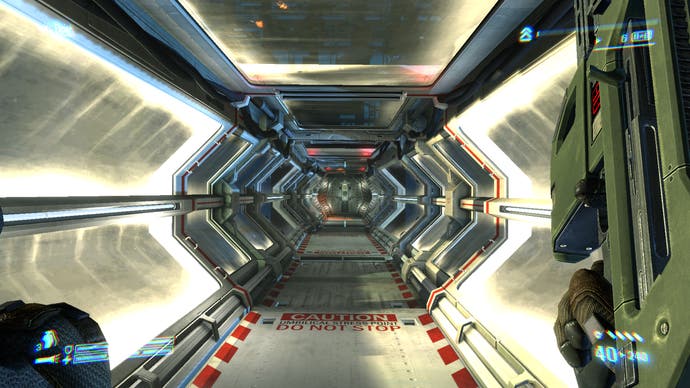
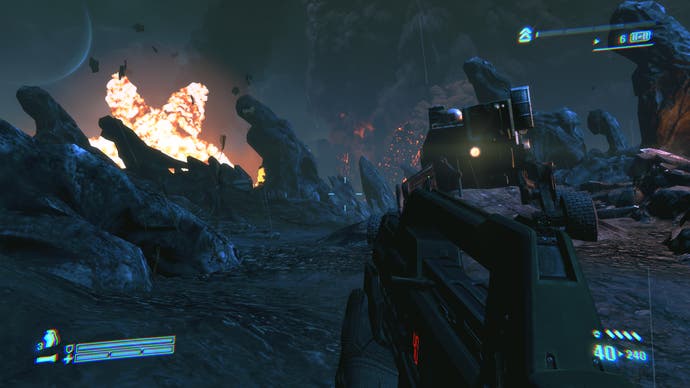
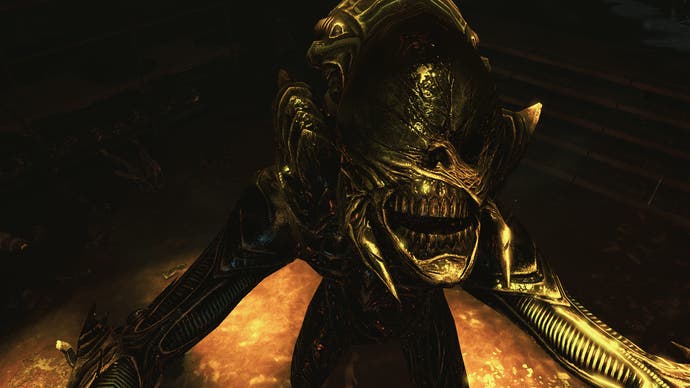

Despite the improved texture assets, the PC version's directory weighs in at the same ballpark 6.2GB as the 360 version, and its video files share are of the exact same sizes as the console releases. An FXAA mode is also present via a toggle, though this produces a degree of residual blurring to the image in exchange for thorough edge treatment. It's perhaps a shame there's no a multi-sample option as well; even forcing MSAA into the game via Nvidia's control panel doesn't work, causing a conflict with the renderer that results in a black screen.
Aliens: Colonial Marines - performance analysis
The 360 may trail somewhat in the visual stakes to the PS3, but its level of smoothness in gameplay is another matter. Here, we analyse a selection of like-for-like cut-scenes to get a sense of the baseline performance on each platform, before we dive into the hectic shoot-outs that comprise the rest of the game.
First off, the basics: the 360 version feels undoubtedly smoother due to its unlocked frame-rate, while the PS3 soft-locks to just 30FPS. On paper this suggests an advantage for Microsoft's platform, but the reality is that the frame-rate only hits maximum capacity while looking at the ceiling. For the rest of play, we're looking at a 40FPS baseline with frequent drops below this once the action starts - well demonstrated during the first cut-scene in our compilation, with the exploding bridge.
"Frame-rate is disappointing on PS3 and far more variable on 360 owing to an uncapped update, accompanied by horrendous levels of screen-tear."
On the Sony side, the decision to cap the frame-rate at 30FPS is a logical choice that remains barely more stable than the 360's wavering figure. Even so, when dips do occur it can be distracting, producing more visible screen judder at 20FPS than we ever see on 360. The benefit of operating at this figure is that by maintaining a frame-rate that is more easily attained, the PS3 avoids many of the tearing issues plainly visible on the rival console. Even when running through narrow hallways uncontested by enemies, there's a perpetual full-screen tear at play on 360, whereas Sony's hardware only gives in once alpha effects and a multitude of xenomorphs hit the screen.
In this sense, the adaptive v-sync option would have been a much better fit for the 360 - a best-of-both-worlds proposition. During points of greatest stress, performance remains higher than the PS3's across matching dips, and locking to a modest 30FPS would have resulted in fewer tearing artifacts. Even so, the game animates at a smoother rate overall on Microsoft's platform, despite the missed opportunity to truly optimise further.
Talking PC performance, it's worth making a cursory note that the new lighting model has had little impact on the Unreal Engine 3's all-around scalability on PC. Drops below 60FPS while maxed out are very rare indeed for our Intel i5-2500K based PC, equipped with a GTX 670, which proves par for course given previous releases like Borderlands 2 and Dishonored
"It's difficult to recommend any version of this game - even after its extended period of development it still looks unfinished and is packed with bugs."
Aliens: Colonial Marines - the Digital Foundry verdict
All in all, it'd be churlish to expect every shooter to match the technical accomplishments of pack leaders like Halo 4 or Killzone 3, but Aliens: Colonial Marines is stuck too many years behind the curve to deliver even on its limited ambitions. While there is some evocative work put into the level design, you can see the game's roots in 2008, around the time it was first announced. Image quality is garishly reminiscent of the first wave of fuzzy-textured Unreal Engine 3 titles on console, and the scatter-brained AI, collision detection glitches, and rigid, weightless xenomorph animations all amount to an underwhelming extension of the Aliens universe.
If you're committed to buying this for any platform, make sure it's PC. It still has its glitches; the Alien Queen boss passes through concrete walls during a one-on-one encounter, and it's still possible to fall through the ground on occasion, only to float around until deciding to restart. However, it's the version that avoids the constant screen-tearing of the 360 version, which appears to a lesser extent on PS3. It's also the edition that resolves all aliasing issues present on both consoles, and does it while adding the fully dynamic lighting system we were promised - plus higher-resolution textures on characters.
In the final call, it's hard to recommend either console release, but at a push we find the 360 one marginally more playable due to it holding above 30FPS through thick and thin. The PS3 version offers certain advantages in the image quality department, such as running at the full 720p framebuffer, as opposed to the 360's softer sub-HD output, but when the frame-rate drops for Sony's console it's ultimately even more of a distraction. Looking to the upcoming Wii U version, confident claims are made by Gearbox's Randy Pitchford that it offers the "best looking and best console performance version of the game". Coming from a background of solid PC ports, here's hoping Demiurge Studios is able to not just adapt the game to the GamePad layout, but use the extra time to optimise appropriately for Nintendo's hardware.






